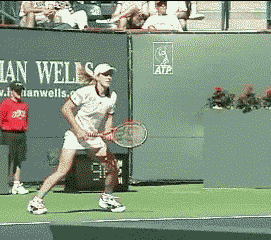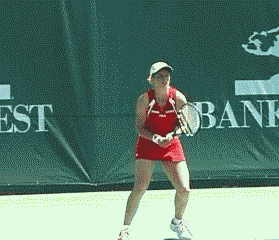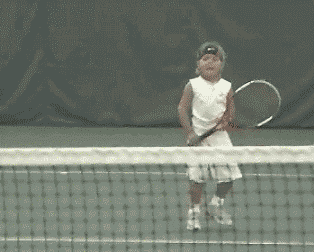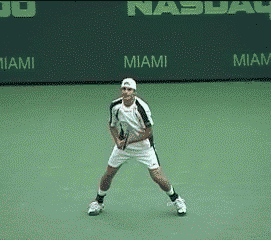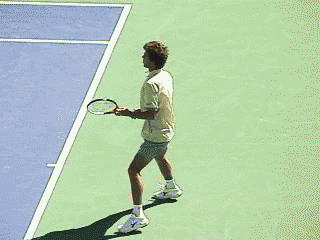|
TennisOne Lessons One-Handed Backhand vs Two-Handed Backhand Which one is right for your game? Dave Kensler - Peter Burwash International (PBI) While many of the professional players have made their choice on whether to use a one-handed or two-handed backhand and rarely do we see anyone at that level change from one to the other (except when hitting underspin). However, I still have many adults and juniors who have some degree of uncertainty as to which of the two will be better suit their games.
Here are some issues to look at when comparing the two strokes. Strength Is Not a Key Factor The issue of strength is the most misleading aspect of the one-handed vs two-handed debate. I learned how to play tennis in the mid-60’s at age 12 through a city parks and recreation department summer program. All the boys and girls in the class had adult-sized wooden racquets. There were no so-called “Junior racquets” nor were there racquets made of ultra-light materials like we have today. We had one instructor for 10-15 kids and he taught everyone the one-handed backhand. Why? Probably because it was the preferred stroke at the time and almost all the professional players used the one-handed backhand. Nobody really “knew” of a two-handed backhand stroke and I doubt the instructor would have known how to teach it.
Therefore, the notion in this day and age of adults and juniors not being strong enough to hit a 2-ounce ball while swinging an 8-10 ounce racquet with their dominant arm is absurd. Everyone is strong enough. If a backhand (Or any stroke) feels “weak” then refer to my previous article on using the last three fingers of your hitting hand. A conversation I had a few years ago with a martial arts instructor added further insight to this issue. He told me there are far more “strong blows” with a backhand motion than forehand motion in martial arts. Whatever choice you make on whether to use a one-handed or two-handed backhand, please use reasons other than “strength.” After all, the top male player (Federer) and top two female players (Mauresmo and Henin-Hardenne) in the world have one-handed backhands. Choose One as your Primary Backhand Sometimes I have students who are so indecisive they keep switching back and forth between the two. I would not recommend this approach. It is important to decide which of the two you are going to use because the emphasis on how to hit each backhand is different. For a one-handed backhand, obviously it is your dominant arm swinging the racquet. With the two-handed shot it becomes more like a forehand with the non-dominant hand i.e. If you are right-handed then your two-handed backhand will be similar to a left-handed forehand as the left-hand will drive the racquet head through the shot. A common problem occurs when two-handed players try to lead with their dominant arm. In other words, they have both hands on the grip but swing like a one-handed backhand stroke. This may feel more natural in a sense because it is their dominant arm swinging; however, it often leads to a “push” shot without much pace.
You can still hit a two-handed backhand by leading with your dominant arm but because your non-dominant hand is also on the grip, the length of your swing and contact area will be severely limited. One checkpoint you can use is to see where the elbow of your dominant arm is at the end of the stroke. If you are a right-handed player then on a two-handed backhand the right elbow should be bent and relatively close to your body (Maybe 8-10 inches away) at the end of the follow-through. This means you "drove" the racquet head through the contact area with your left-hand. If you lead or "push" with your right arm then at the end of the stroke your right elbow will be straight and much further from your body. Two-Handeder Should Practice their One-Handed Backhand As someone who has a one-handed backhand, I am never forced to hit a two-handed shot during a match. However, two-handed players will be forced to hit one-handed shots (It happens all the time with the pros). Here are three common situations (There are others) when this will become necessary:
I always encourage my two-handed playing students to spend time practicing their one-handed backhand because they will be forced to use it at some point. It is also more difficult for a two-handed player to change pace or tactics than a one-handed player. How many two-handed backhand tour players have a good underspin shot? Many of them hit dropshots but you won't see a high number of underspin ground strokes. Yet Federer as one example, will often hit both a topspin and underspin (and even flat) backhand during the same point! One reason for this seemingly greater flexibility in options with a one-handed backhand is because it takes less effort to hit it. If necessary, a player using a one-handed backhand can move their racquet head only six inches and hit a solid flat or underspin one-handed backhand. The All-Court Game If your goal is to develop an all-court game like Roger Federer (Wouldn’t we all?!), then I would recommend a one-handed backhand. Why? If for no other reason, “the reach factor.” With a one-hander you can cover more space than with a two-hander and this will have an even greater impact when playing the net. If we use the pros for purposes of comparison, it becomes evident that few, if any, of the great net players hit two-handed backhands from the baseline. Even today, with many two-handed players on the tour, the best net players have one-handed backhands.
Earlier this year I was at press conference during the Pacific Life Open with Andre Agassi. Someone asked him if he had any regrets not developing a better net game during his career. Agassi replied, “There are times when it would have definitely helped me to come into the net and finish the point more quickly but have you seen my volley lately?!” In my professional opinion, if you commit yourself to a two-handed backhand from the baseline then you are also agreeing to have at best an average net game. This is very apparent at the club level. Think about who the best volleyers are in your group. My guess is that it is the one-handers. So, unless you have the time to practice a two-handed backhand baseline game and a one-handed backhand net game, your volleys will most likely suffer a bit. Doubles and the Two-Handed Backhand Volley In many of the doubles clinics I do, the issue of two-handed volleys comes up. Obviously “the reach factor” is less (But not completely eliminated) of an issue in that two people are covering the court. However, compared to a one-handed backhand volley, “weak spots” still exist.
What To Expect If You Make The Switch Whether you go from a one-handed backhand to two hands or vice versa, expect your game to be challenged for a while. This transition, with the exception of going from being a right-handed player to playing left-handed (Or vice versa) is arguably one of the most difficult to adjust to. It might be a good idea to practice with people a level below you. If you are 4.0 player then hit with a 3.5 player to help build your confidence.
Any time we add new features to our tennis game they are difficult to practice and implement if we play against people who are at our level or above. In part, because shots which normally would not give us much trouble, now put us in emergency situations. Hitting on the ball machine or with a teaching pro will help too. One thing is certain, if people know you have made the change they are going to test you in match play! The other important issue for many players which becomes a part of this scenario is the fear of losing. The good intentions of adding new components to how we play tennis go away quickly when we are in a competitive situation and losing or performing poorly. The thought becomes, "I will work on my new serve in the next match but now I have to concentrate on winning this one." One of the most famous stories on this subject is when Pete Sampras was around 15-years old and made the switch from a two-handed backhand ground stroke to a one-handed backhand because he knew it would be better for his all-court game. After making the change he lost in the first round in something like 15 of the next 17 tournaments he competed in! But his focus was on the future, not the present. Some five years after Sampras made the change, he won his first U.S. Open! Very few additions or changes to our tennis game will provide instant, winning success. It is a building process and it takes a while to gain confidence and be able to execute under pressure and in competitive situations. One of the most basic questions you need to ask yourself is, "Is losing a match today, even if it is one I would normally win, that big of deal compared to the matches I want to win next year or five years from now?" In other words you must decide whether winning is more important than improving. You can; however, minimize the emotional toll of losing when trying new things by:
Remember These Checkpoints On Each Stroke
For a one-handed backhand think knuckles forward as you swing. This will help reduce the chances of “flipping” your wrist at contact and your arm moving in a semi-circle rather than a straight line. For a two-handed backhand, think forehand with your non-dominant hand. This will help ensure a strong swing instead of a push shot with your dominant arm. In addition, this technique will contribute to keeping your dominant hand and arm more relaxed during the stroke, as the natural tendency is to take control of the swing with your dominant side. Regardless of whether you use a one-handed or two-handed backhand, they both require lots of practice! Your comments are welcome. Let us know what you think about Dave Kensler's article by emailing us here at TennisOne.
Dave Kensler has 24 years of teaching experience with Peter Burwash International (PBI), the most successful international tennis management company.PBI directs tennis programs at 60+ exclusive resorts and clubs in 23 countries and has taught over three million students in their 30 year history. For information on PBI tennis destinations and employment opportunities please go to www.pbitennis.com.All PBI Tennis Professionals play with WILSON racquets and wear WILSON shoes. |

